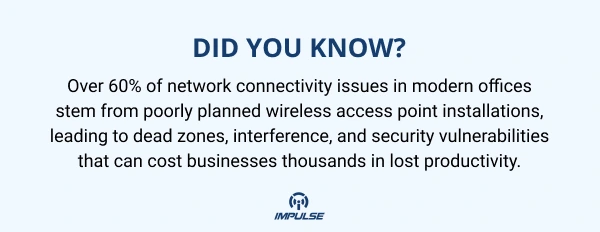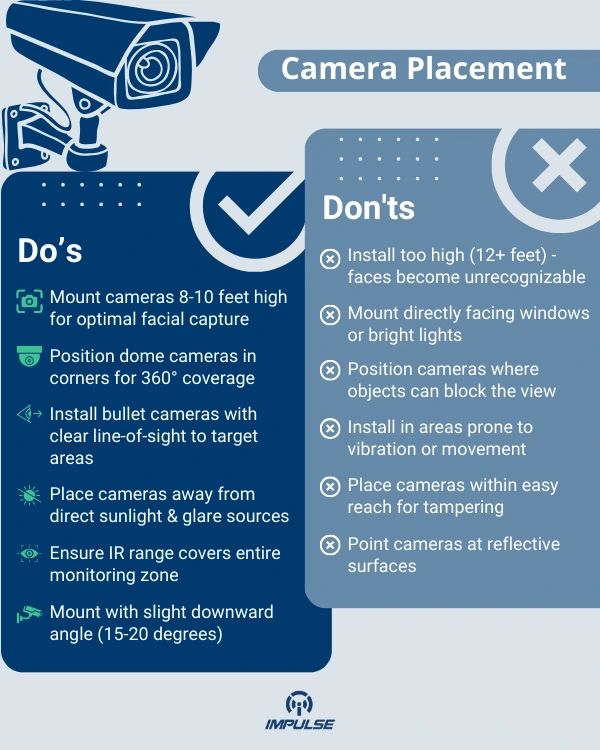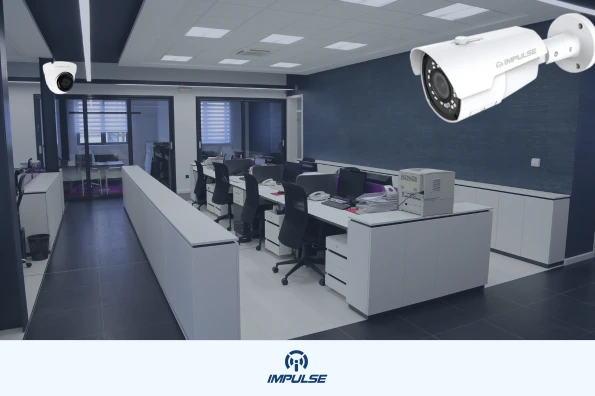In today’s hyper-connected business environment, wireless network infrastructure forms the backbone of organizational productivity. Whether you’re managing a sprawling corporate campus or a multi-floor office building, the strategic deployment of wireless access points (WAPs) can make the difference between seamless connectivity and network nightmares. However, the complexity of modern enterprise wireless solutions means that even experienced IT professionals can fall into costly installation traps.
The integration of advanced security systems, such as IP surveillance cameras and network video recorders, with wireless infrastructure has become increasingly critical. Modern surveillance solutions like the Fixed lens Network Bullet Camera (IMP-LX-BLTF-300-3600) require robust wireless connectivity to deliver real-time monitoring and edge analytics capabilities across large installations.
This comprehensive guide will walk you through the five most critical mistakes that can derail your wireless access point installation project, providing you with actionable insights to ensure optimal network performance, security, and scalability.

The Hidden Costs of Wireless Network Failures
Network downtime in enterprise environments costs an average of $5,600 per minute, according to recent industry studies. When wireless access points fail or underperform, the ripple effects extend far beyond simple connectivity issues. Consider the impact on:
- Real-time surveillance systems requiring constant network connectivity
- Cloud-based applications and remote work capabilities
- IoT devices and smart building management systems
- Guest network access and customer experience
- Compliance requirements for data security and network monitoring
The stakes are particularly high when integrating advanced surveillance equipment like the Varifocal Network Bullet camera (IMP-LX-BLTZ-300-2812), which relies on stable wireless connectivity to stream high-definition video, support quad streaming capabilities, and maintain edge analytics functionality across distributed campus environments.
Understanding the Critical Installation Mistakes
Mistake #1: Inadequate Site Survey and Coverage Planning
The foundation of any successful wireless network deployment lies in comprehensive site surveying. This critical error manifests in several ways:
Poor Signal Propagation Analysis: Many installers underestimate how building materials, furniture, and environmental factors affect Wi-Fi signal strength. Concrete walls, metal fixtures, and even large water features can create significant dead zones in your coverage area.
Insufficient Access Point Density: Attempting to cover large areas with too few access points leads to weak signal zones and poor user experience. Modern enterprise wireless standards like Wi-Fi 6 require careful consideration of device density and bandwidth requirements.
Overlooking Vertical Coverage: Multi-story installations often focus solely on horizontal coverage, neglecting the unique challenges of providing consistent wireless service across different floor levels.
Integration Challenges with Surveillance Systems: When planning wireless infrastructure for facilities using advanced security equipment like the MOTORIZED IR-DOME CAMERA (IMP-LX-DOMZ-500-2812), installers must account for the high-bandwidth requirements of 5MP video streaming and real-time edge analytics processing.
Mistake #2: Ignoring Interference and Channel Management
Radio frequency interference represents one of the most overlooked aspects of wireless deployment in dense environments.
Co-channel Interference: Installing multiple access points on the same or overlapping channels creates network congestion and dramatically reduces performance. This is particularly problematic in office environments with high device density.
Adjacent Channel Interference: Even non-overlapping channels can interfere with each other when access points are positioned too closely, creating network bottlenecks that affect critical applications.
External Interference Sources: Microwave ovens, Bluetooth devices, and even nearby wireless networks can disrupt your carefully planned wireless infrastructure. Professional site surveys should include spectrum analysis to identify potential interference sources.
Impact on Surveillance Applications: High-definition surveillance systems like the Varifocal Network Box camera (IMP-LX-BOX-300-0000) require consistent, interference-free connectivity to maintain 4K recording capabilities and support advanced features like WDR and motion detection analytics.

Mistake #3: Poor Power Planning and Cable Management
Power over Ethernet (PoE) planning failures can cripple even the most well-designed wireless networks.
Inadequate PoE Budget Calculation: Modern enterprise access points require significant power, especially when supporting advanced features like beamforming and high-density client support. Underestimating power requirements leads to access points operating at reduced functionality or failing entirely.
Distance Limitations: PoE standards have specific distance limitations that affect both power delivery and data transmission. Exceeding these limits without proper planning can result in intermittent connectivity issues.
Cable Quality and Certification: Using substandard cabling or failing to properly test and certify network cables leads to long-term reliability issues and difficult-to-diagnose network problems.
Integration with Security Systems: When deploying comprehensive security solutions that include the 16 CH Network Video Recorder (IMP-LX-NVR-265-1602) alongside wireless access points, power planning becomes even more critical as these systems require 320Mbps recording bandwidth and substantial processing power for 4K resolution management.
Mistake #4: Inadequate Security Configuration
Weak Authentication Protocols: Many installations still rely on outdated security standards like WPA2, when WPA3 enterprise security should be the minimum standard for business environments.
Default Configuration Vulnerabilities: Failing to change default passwords, SNMP community strings, and administrative credentials creates easy entry points for malicious actors.
Guest Network Isolation: Improperly configured guest wireless networks can provide unintended access to internal resources and compromise overall network security.
Network Segmentation Failures: Modern office environments require sophisticated VLAN configuration to isolate different types of traffic, including guest access, employee devices, and IoT surveillance equipment.
Monitoring and Logging Deficiencies: Without proper logging and monitoring configuration, security incidents can go undetected for extended periods, allowing potential breaches to escalate.
Mistake #5: Neglecting Future Scalability and Maintenance
Short-term Thinking: Many wireless installations focus solely on immediate needs without considering future growth, technology evolution, and changing user requirements.
Inadequate Network Management: Deploying access points without centralized management capabilities makes ongoing maintenance, troubleshooting, and optimization extremely difficult in enterprise wireless environments.
Firmware Update Planning: Failing to establish procedures for regular firmware updates and security patches leaves networks vulnerable to known exploits and prevents access to performance improvements.
Documentation Deficiencies: Poor documentation of network configuration, access point locations, and design decisions makes future maintenance and troubleshooting challenging and time-consuming.
Integration Planning: Modern offices increasingly rely on integrated systems where wireless infrastructure supports not only computing devices but also surveillance systems, building management, and IoT applications. Failing to plan for these integrations limits future expansion capabilities.
Building a Future-Proof Wireless Infrastructure
The difference between a basic wireless installation and a professional enterprise deployment lies in attention to detail, comprehensive planning, and integration with broader organizational technology goals. When properly executed, your wireless infrastructure becomes an enabler of business growth rather than a limiting factor.
Consider the synergies possible when wireless infrastructure seamlessly supports advanced surveillance capabilities. High-performance surveillance systems can leverage robust wireless networks to provide:
Enhanced Security Coverage: Professional installations that properly integrate wireless access points with advanced surveillance equipment create comprehensive security ecosystems that protect both digital assets and physical premises.
Centralized Management: Modern network infrastructure enables centralized monitoring and management of both connectivity and security systems, reducing operational complexity and improving response times.
Scalable Architecture: Well-designed wireless networks accommodate growing surveillance requirements, additional access points, and evolving security technologies without requiring complete infrastructure overhaul.
Cost-Effective Expansion: Proper initial planning reduces long-term costs by eliminating the need for frequent network redesigns and allowing for organic growth as organizational needs evolve.
Professional Installation Best Practices
Comprehensive Pre-Installation Planning
Professional Site Survey: Engage certified wireless professionals to conduct thorough RF site surveys using calibrated equipment and industry-standard methodologies. This investment pays dividends in network performance and user satisfaction.
Capacity Planning: Calculate current and future bandwidth requirements, considering not only traditional computing devices but also bandwidth-intensive applications like high-definition surveillance streaming and real-time analytics processing.
Integration Planning: Develop comprehensive integration strategies that account for all connected systems, including security cameras, access control, building management, and IoT devices.
Implementation Excellence
Professional Installation Teams: Utilize certified installers with demonstrated expertise in enterprise wireless deployment and PoE networking. Proper installation techniques ensure optimal performance and longevity.
Quality Components: Invest in enterprise-grade access points, switches, and cabling that meet current standards and provide headroom for future requirements.
Comprehensive Testing: Implement rigorous testing protocols that verify coverage, capacity, security, and integration functionality before network deployment.
Ongoing Optimization
Performance Monitoring: Establish baseline performance metrics and implement continuous monitoring to identify and address issues before they impact users.
Regular Maintenance: Schedule periodic wireless network optimization, including channel analysis, access point positioning adjustments, and security configuration reviews.
Documentation Management: Maintain comprehensive documentation of network configuration, performance baselines, and change management procedures.
Advanced Integration Considerations
Modern office environments increasingly require converged network infrastructure that supports multiple critical systems simultaneously. The integration of advanced surveillance systems with wireless infrastructure exemplifies this trend, requiring careful consideration of:
Bandwidth Management: High-definition surveillance systems require substantial bandwidth for features like quad streaming, real-time analytics, and remote monitoring capabilities.
Quality of Service (QoS): Implementing proper QoS policies ensures that critical applications like security monitoring receive priority network access during periods of high utilization.
Network Redundancy: Mission-critical applications require redundant network paths and failover capabilities to maintain continuous operation.
Security Integration: Modern surveillance systems integrate network security monitoring with physical security management, requiring sophisticated network segmentation and access control policies.
Conclusion
Avoiding these five critical mistakes in wireless access point installation requires a combination of technical expertise, comprehensive planning, and attention to long-term organizational needs. The investment in professional design and installation pays dividends in network performance, security, and scalability.
Modern business environments demand wireless infrastructure that not only provides connectivity but also enables advanced applications like high-definition surveillance, real-time analytics, and integrated security management. By avoiding these common pitfalls and implementing best practices, organizations can build wireless networks that serve as foundations for growth and innovation.
The complexity of modern enterprise wireless solutions makes professional expertise essential for successful deployments. From initial site surveys through ongoing optimization, the difference between amateur and professional installation becomes evident in network performance, user satisfaction, and total cost of ownership.
Remember that wireless infrastructure investments should be viewed through the lens of long-term value creation. Properly designed and installed networks provide the foundation for emerging technologies, changing work patterns, and evolving business requirements.
Skip the common installation mistakes that compromise connectivity and security. With decades of experience in enterprise wireless deployment and integrated security solutions, Impulse delivers optimal performance, security, and scalability for your network from initial site surveys through ongoing optimization.


